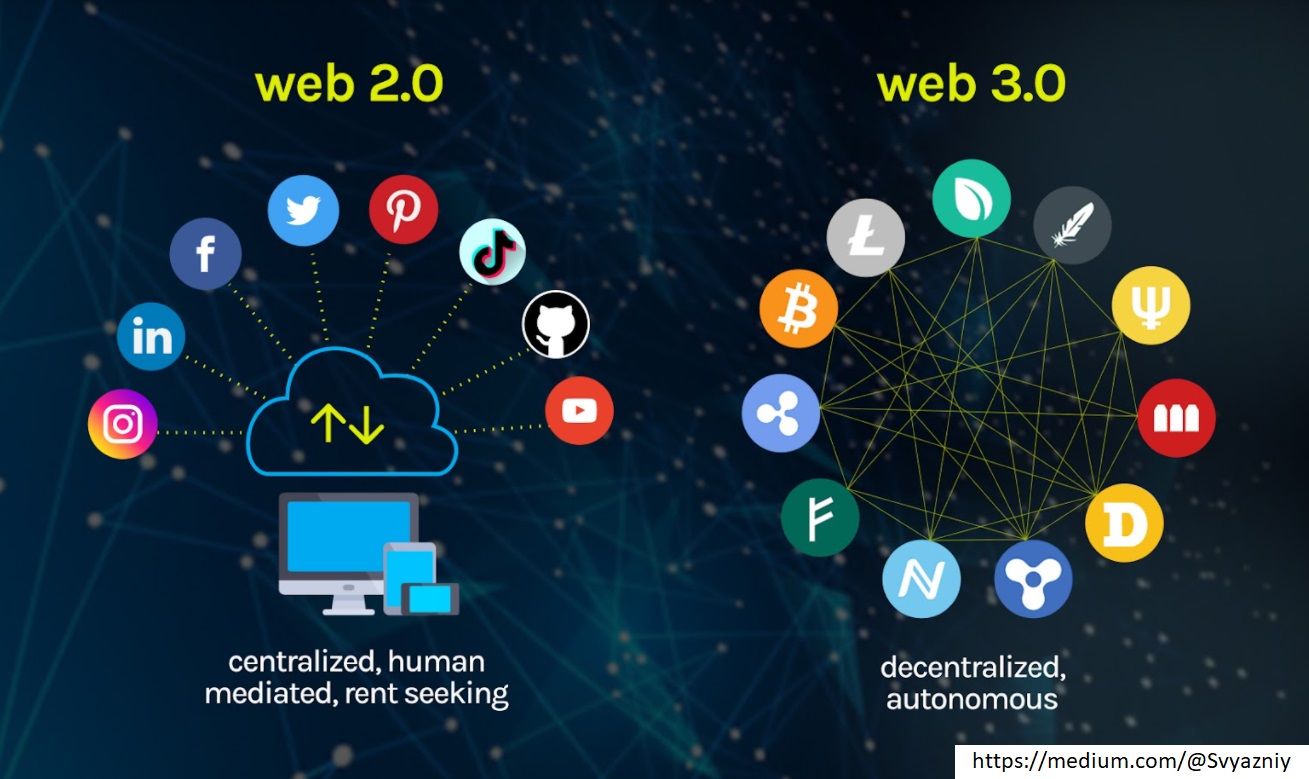Web 2 & Web 3: Differences Explained

Web 3 is also referred to as the semantic web, whereas Web 2 serves the current internet generation. Let's look at these ideas, how they differ, and which one will dominate in the next ten years.
From the early days of Web 1, which featured static texts and images, to the present day of Web 2, the Internet has advanced quickly. The Web 3 age, picking up steam as blockchain and security technology, in which value and data may readily move across decentralised platforms with distributed ownership and control, is only now beginning. What else does Web 3 offer, though? What distinguishes it from Web2?
Tim Berners-Lee first described the first iteration of the web in 1989. Web 1, as it is sometimes known, focused on basic connectivity and hyperlinks. The idea expanded with the invention of the web browser, which made it simple for regular users to see web pages. In 1993, the NCSA Mosaic web browser became the first of its kind. Marc Andreessen, later a co-founder of Netscape, one of the early web-based businesses, contributed to its creation.
With little to no video content and a page style that closely resembled that of a printed page, the initial generation of the web was largely static. With the introduction of Web 2, the second generation of the web, all of that was altered in 2006.
Web 2.0
Web 2 is still in use today all around the world. It has completely altered the web and the supporting industries. Users can now gather, produce, and distribute massive volumes of data with just one click thanks to this web version. Phones come with an integrated camera that today's true Web 1 cameras just could not manufacture. The ability for users to produce content and share it across international networks is Web 2's strongest feature. Web 2.0 provided new types of interactivity as opposed to just static websites that delivered content to internet users. Blogging concepts gained popularity, and social networks like Friendster, MySpace, and finally Facebook started to appear.
Web 2 has ushered in the era of user-generated content by bringing social media into existence. Data stored on servers owned by large organisations and institutions was a common thread in earlier iterations. Even if the user had originally created the data, they ultimately weren't the real owners.
Web 3.0
The term Web 3 has not been well defined because it is still in its early stages of development. Even the date of the term's invention is up for discussion. While Ethereum co-founder Gavin Wood first used the phrase Web 3 in 2014 in relation to cryptocurrencies, Berners-Lee initially coined the term Web 3.0 to describe what he called a Semantic Web in 2006.
The term "Web 3.0" refers to ideas that are far higher level than the Semantic Web concepts promoted by the W3C (World Wide Web Consortium), such as decentralisation. Web 3 is founded on peer-to-peer and consensus algorithms rather than the same centralised techniques to connectivity and data that form the backbone of both Web 1 and Web 2. Blockchain technology is a crucial component of the distributed consensus for Web 3.
Cryptocurrencies, which offer an additional method for making payments and transferring wealth, are integrated as part of the Web 3 movement toward decentralisation. Additionally, the idea of non-fungible tokens (NFTs) offers an additional method for developing, controlling, and owning assets utilising blockchain technology.
Web 2 v.s. Web 3: Differences
Web 2.0 and Web 3.0 have comparable technology and histories, but they take distinct approaches to challenges. Web 2.0 made the internet more interactive and social. Web 3.0 will make the web more distributed and intelligent than ever before.
The key difference is that Web 3 places more emphasis on producing content than Web 2 does on consuming and writing it (Semantic Web). The latter is significantly superior because it makes use of technology to improve cybersecurity while also facilitating information exchange among web users.
While Web 2 seeks to connect individuals, because of decentralisation, Web 3 integrates this data in order to increase trust while also giving it significance.

Next reality of the Internet?
Web 3.0 is currently being developed and defined. Because of this, there are numerous unanswered questions regarding the final form of Web 3.0.
New internet standards that alter how the web functions may be part of Web 3.0. One such protocol, which has long been based on TCP/IP protocols, is HTTP (Hypertext Transfer Protocol). The Internet Engineering Task Force is developing HTTP/3, or HTTP version 3. TCP/IP is replaced with the QUIC transport protocol, which offers greater robustness, performance, and scalability.
Play-to-win (P2W) games, non-fungible tokens (NFTs), and decentralised autonomous organisations (DAOs) are just a few of the new consumer behaviours that have recently been introduced by Web 3.0 companies (DAOs).
As the standard for a new online age, Web 3.0 can be seen as a set of guidelines and expectations for all internet users.
Web 3.0 would thus be applicable to all applications rather than just a select few.
Decentralisation, automation, and intelligence will probably continue to be the cornerstones of what comes after Web 3.0 as it develops and is defined.
ARTICLE SOURCES
- Techtarget. "Web 2.0 vs. Web 3.0: What's the difference?,https://www.techtarget.com/whatis/feature/Web-20-vs-Web-30-Whats-the-difference".
- Spiceworks. “Web 2 vs. Web 3: What’s the Difference and Why It Matters, https://www.spiceworks.com/tech/tech-general/articles/web-2-vs-web-3/”.
Consortium 21 is heralding a new era for businesses to take advantage not only with their existing marketing efforts… but also by implementing Web 3.0 technologies within them - empowering people across global networks to learn, earn, shop, and socialize.
If you’re interested to explore collaboration in the Metaverse space, reach out to Consortium 21 via email: admin@consortium21.com
Also, join our Telegram community for news, giveaways, insights from experts about MarTech, web 3.0, and more exciting activities to be announced in Telegram.
